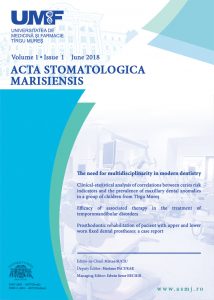Teeth are fundamental to the quality of life throughout the human existence [1]. An association between tooth loss and osteoporosis has been reported in the literature. Women with osteoporosis are three times more likely to experience tooth loss than those who do not have the disease [2,3].
Osteoporosis as described by World Health Organization (WHO) is a progressive systemic skeletal disease characterised by low bone mass and micro architectural deterioration of the bone tissue, with a consequent increase in bone fragility and susceptibility to fracture. The main treatment of osteoporosis involves the use of Bisphosphonates (BPs) to improve bone density and new bone growth. BPs act on macrophages in the blood reducing their life span and causing morphological alterations and changes in differentiation of monocytes into macrophages. This reduces the body’s ability to defend against pathogens [4].
The action mechanism of BP is based on the inhibition of the farnesyl diphosphate synthase enzyme (FPPS), which in turn stimulates isoprenylation of small guanosine-5′-triphosphatases (GTPases), which signals proteins that activate and regulate changes in osteoclast morphology [5].
There have been studies with a low level of specificity and many of them with a small number of clinical cases or a poorly defined control group that cannot suggest a direct link between BPs and implant failure. Therefore, the BPs effect on implant ostointegration is not well established [6].
Subclinical hypothyroidism (SCH) is defined by the presence of serum free thyroxine levels (FT4) and triiodothyronine (FT3), within reference limits, in the presence of thyroid stimulating hormone (TSH) levels [7]. There is evidence to suggest that subclinical hypothyroidism is also linked to dyslipidemia and osteoporosis [8]. It is diagnosed based on symptoms and clinical signs associated with low thyroid stimulating hormone (TSH) levels [9]. There are studies that confirm the association of low levels of TSH with bone demineralization and alteration of trabecular bone structure. [10,11].
Patients with SCH can present with anxiety, irritability, poor concentration, slow information processing, and poor learning in comparison to healthy subjects [12].
Psychiatric illnesses such as anxiety, bipolar disorder or depression, as well as the medication associated with these diseases can reduce salivary secretion to the appearance of xerostomia [13].
Ciprian-Emanuel Rusu 1, Serfözö Norbert Erich 1, Andrei Petruț 1, Carmen Biriș 1, Claudiu Horga 1
1 Faculty of Dental Medicine, University of Medicine and Pharmacy of Tirgu Mures, Romania
1 Faculty of Dental Medicine, University of Medicine and Pharmacy of Tirgu Mures, Romania

Comments are closed.